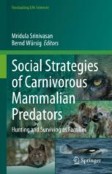Search
Search Results
-
Cognition of the manatee: past research and future developments
In this paper, we present a review of the current knowledge related to the cognitive abilities of the manatee, with a focus on the Antillean manatee...

-
Communication sounds produced by captive narrow-ridged finless porpoises (Neophocaena asiaeorientalis)
Toothed whales are the ideal model to validate the hypothesis that the complexity of sound communication relates to sociality. Compared to the...

-
Social group size influences pathogen transmission in salamanders
AbstractIndividuals within animal societies are expected to mitigate the costs and enhance the benefits associated with group living. For example,...

-
Scaffolding cooperation in human groups with deep reinforcement learning
Effective approaches to encouraging group cooperation are still an open challenge. Here we apply recent advances in deep learning to structure...

-
Infant adoptions in wild bonnet macaques (Macaca radiata)
Though uncommon, adoption of orphaned infants has been observed in both wild and captive non-human primates. In two groups of wild bonnet macaques ( Ma...
-
Survival and productivity benefits of sociality vary seasonally in the tropical, facultatively eusocial bee Megalopta genalis
Tropical habitats are characterized by strong wet and dry seasons, but the effects of seasonality on the costs and benefit of sociality are largely...

-
Maternal Aggression and Juvenile Sociality in Hibiscus Harlequin Bugs
Hibiscus harlequin bugs ( Tectocoris diophthalmus ) are Australian jewel bugs known for their maternal care behavior, gregariousness and warning...

-
Floral species evenness is the major driver of wild bee communities in urban gardens
Urban gardens have the potential to contribute to urban bee biodiversity. However, studies considering the effects of habitat amount and floral...

-
Group formation and the evolutionary pathway to complex sociality in birds
Group-living species show a diversity of social organization, from simple mated pairs to complex communities of interdependent individuals performing...

-
Attractiveness of female sexual signaling predicts differences in female grou** patterns between bonobos and chimpanzees
Here we show that sexual signaling affects patterns of female spatial association differently in chimpanzees and bonobos, indicating its relevance in...

-
Temporal variation in the behaviour of a cooperatively breeding bird, Jungle Babbler (Argya striata)
Time is an important and limited resource that can drive the trade-off between various essential activities in the lives of animals. Group-living...

-
Circadian Behavioral Rhythms in Social Insects
The highly developed sociality of insects has been well studied from the perspectives of animal behavior, physiology, and ecology. However, less...
-
Environmental Effects on Bee Microbiota
Anthropogenic activities and increased land use, which include industrialization, agriculture and urbanization, directly affect pollinators by...

-
Animals That Stay Together, Hunt Together
Social mammalian predators typically forage in groups and maintain mostly consistent membership. Within the social unit, there could be a hierarchy...
-
The Role of Food and Mates in Sha** Asiatic Lion Societies
Asiatic lions, once widespread from Persia to eastern India, are now confined as a single population in the Gir forests and the adjoining...
-
Who can pass the urban filter? A multi-taxon approach to disentangle pollinator trait–environmental relationships
Cities are considered important refuges for insect pollinators. This has been shown repeatedly for wild bees, but may also be true for other diverse...

-
Determinants of introduction success in alien mammals
Despite intensive research on colonization by non-native species, ecologists still cannot accurately predict their invasive abilities and likely...

-
Social Strategies of the African Lion
Within the realm of social carnivores, lions (Panthera leo) are the sole representative of the large felids. While other Felidae may tolerate...
-
Extended parental care in the mass provisioning silk wasp, Microstigmus rosae
AbstractInsurance-based mechanisms, where surviving group-members can complete parental care after the death of a nestmate, are key to the origin of...

-
Everybody needs good neighbours: movement, habitat use, and conspecific association in a reintroduced mesopredator
As a reintroduction progresses through the establishment, growth, and regulation phases, density-dependent mechanisms increasingly drive population...

